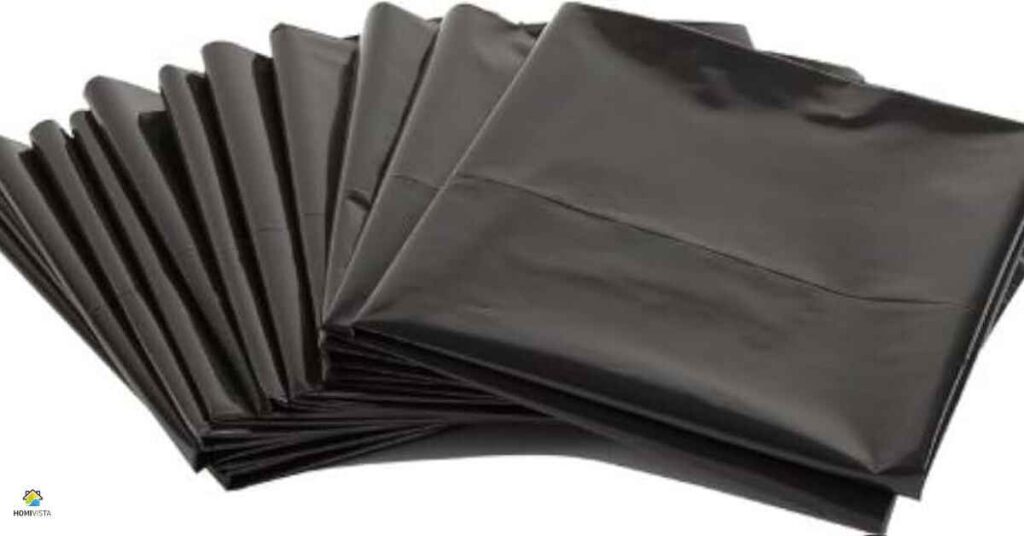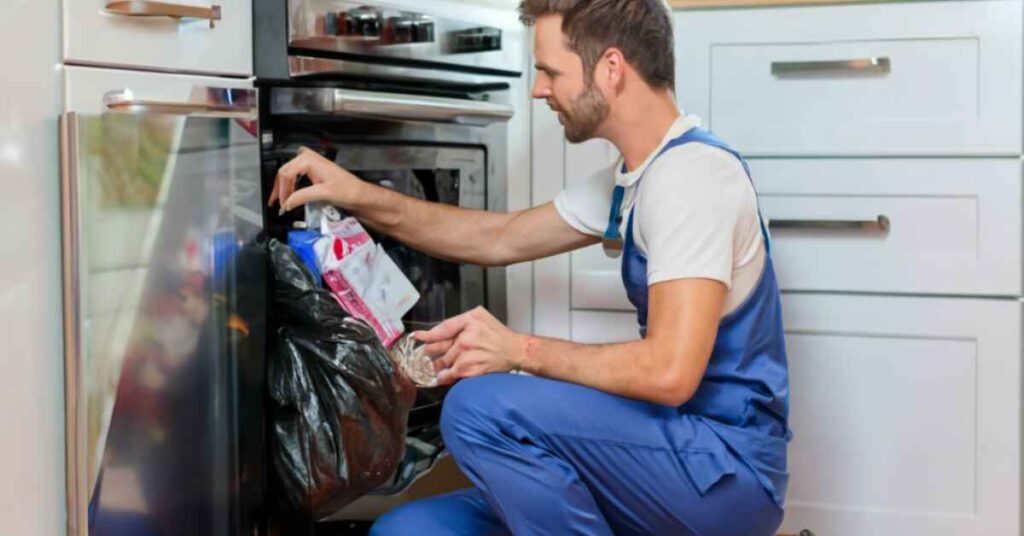Removing a trash compactor involves several steps to ensure a safe and efficient process. First, disconnect the power supply and remove any trash or debris from the compactor. Next, uninstall the compactor by loosening and removing the screws or bolts securing it to the cabinet or floor. Use caution and proper tools to avoid damage or injury during this step.
Once the compactor is detached, carefully lift and maneuver it out of its installation space. It’s taking care not to scratch or damage surrounding surfaces. Finally, dispose of the compactor responsibly or store it for reuse if possible.
The Importance of Using Trash Compactor Bags
The importance of using trash compactor bags lies in their ability to contain and manage waste effectively. The compactor bags are designed to withstand the pressure and force exerted by the compactor, preventing tears and leaks. This ensures that the waste remains securely contained, reducing the risk of spills and messes.
Using compactor bags helps maintain cleanliness and hygiene in the compactor unit and surrounding areas. Compactor bags contribute to environmental sustainability by reducing the volume of waste. They enable more efficient waste disposal as compacted trash takes up less space in landfills or disposal sites.
This helps conserve valuable landfill space and reduces the environmental impact of waste disposal. The use of compactor bags makes it easier to handle and transport compacted waste, streamlining waste management processes. Overall, the use of trash compactor bags plays a vital role in efficient waste containment, hygiene maintenance and environmental conservation efforts.
Types of Trash Compactor Bags

- The types of trash compactor bags vary based on their material composition.
- This includes plastic bags designed specifically for use with trash compactors.
- They are often made of durable materials such as polyethylene or polypropylene.
- Some compactor bags feature reinforced seams and puncture-resistant properties.
- Biodegradable compactor bags are also available for environmentally conscious users.
- These bags break down more quickly in landfills compared to traditional plastic bags.
- Additionally, there are scented compactor bags that help mask unpleasant odors from waste.
- Some compactor bags come in various sizes to accommodate different compactor models.
- Heavy-duty compactor bags are suitable for compacting dense or sharp objects.
- It’s important to choose compactor bags that are compatible with your specific compactor model for optimal performance.
Read this blog: Can Bed Bugs Crawl On Plastic Garbage Bags?
Selection of Right Size Bag for Your Trash Compactor
The selection of the right size bag for your trash compactor is crucial for efficient waste management. This involves considering the dimensions and capacity of your compactor to ensure a proper fit. It’s essential to measure the interior dimensions of your compactor accurately before purchasing compactor bags.
The use of right size bag prevents overfilling or underutilization of space in the compactor. Overfilling can lead to tears or leaks in the bag, causing messes and potential damage to the compactor. On the other hand, using a bag that is too small results in wasted space and may require frequent bag changes. Therefore, selecting the right size bag for your trash compactor ensures optimal performance and waste containment.
Tips for Filling Trash Compactor Bags Correctly
Follow manufacturer guidelines and safety precautions when handling and filling compactor bags.
Here are some tips for correctly filling the trash compactor bags:
- Ensure the compactor bag is compatible with your compactor model.
- Place the bag securely in the compactor with no gaps or folds.
- Avoid overfilling the bag beyond its recommended capacity to prevent tears.
- Compact waste evenly to distribute weight and reduce strain on the bag.
- Dispose of sharp or bulky items separately to prevent punctures.
- Seal the bag tightly before removing it from the compactor to contain odors and prevent spills.
- Use heavy-duty compactor bags for dense or sharp waste materials.
- Regularly check and replace damaged or worn-out compactor bags to maintain efficiency.
- Store spare compactor bags in a clean, dry place away from moisture or pests.
Tools You’ll Need
Following tools are required for remove a trash compactor:
| Tools | Tool Purpose |
| Screwdriver | Used to remove screws or bolts securing the compactor. |
| Pliers | Helpful for loosening or removing fasteners during disassembly. |
| Wrench | Used to loosen bolts or nuts holding the compactor in place. |
| Utility Knife | Useful for cutting and removing packaging or materials around the compactor. |
| Tape Measure | Essential for measuring dimensions to ensure proper fit and alignment. |
| Safety Gloves | Protects hands from sharp edges or potential hazards during removal. |
| Safety Goggles | Protects eyes from debris or particles while working on the compactor. |
| Vacuum Cleaner | Helps clean up debris or dust accumulated around the compactor. |
| Trash Bags | Used to dispose of any waste or debris removed during the process. |
| Step Stool/Ladder | Provides access to higher areas of the compactor for inspection or removal. |
Top of Form
Trash Compactor Removing Procedure
Use following procedure for removing the trash compactor:
Remove the Trash Compactor Door

To remove the trash compactor door, begin by disconnecting the power supply and ensuring the compactor is turned off. Next, locate the hinges or mounting screws attaching the door to the compactor frame. Use a screwdriver or appropriate tool to loosen and remove the screws or bolts. Carefully lift the door off the hinges or track, taking care not to damage surrounding surfaces. Store the door safely and securely.
Insert the Bag into the Compactor
The process of inserting the bag into the compactor begins with ensuring the compactor is turned off and disconnected from power. Next, open the compactor door and place the bag securely inside, ensuring there are no gaps or folds. Smooth out any wrinkles or creases in the bag to maximize space and prevent tears. Close the compactor door tightly to secure the bag in place for compacting.
Also read: Can Maggots Eat Through Plastic Garbage Bags? The Truth Revealed – Trash Rite
Fill the Bag Correctly
When filling the bag correctly, evenly distribute waste to prevent uneven weight distribution. Avoid overfilling the bag beyond its recommended capacity to prevent tears or spills. Compact waste gently and evenly to maximize space and efficiency. Seal the bag tightly before removing it from the compactor to contain odors and prevent messes.
Remove the Bag from the Compactor

Remove the bag from the compactor, first ensure the compactor is turned off and disconnected from power. Open the compactor door and carefully lift the bag out, avoiding any sharp edges or protrusions. Seal the bag tightly to contain odors and prevent spills. Dispose of the bag properly according to local waste disposal guidelines.
How to Dispose of Trash Compactor Bags
The disposal of trash compactor bags involves tying them securely to prevent spills or leaks. Place them in a designated trash bin or waste collection area according to local regulations. Ensure the bags are properly sealed to contain odors and prevent littering. Avoid placing hazardous or prohibited items in the bags for safe disposal and environmental protection.
Benefits of removing trash compactor
Here are some benefits for removing of trash compactor:
- Efficiently contain and manage waste, preventing spills and messes.
- Compatible with trash compactors, maximizing compaction efficiency.
- Durable construction resists tears and punctures during compaction.
- Helps maintain cleanliness and hygiene in the compactor unit.
- Available in various sizes and strengths to suit different needs.
- Reduces odors by sealing waste securely in the compactor bag.
- Simplifies waste disposal and handling processes.
- Contributes to environmental sustainability by reducing waste volume.
- Saves space in landfills due to compacted waste.
- Provides a cost-effective and convenient solution for waste management.
Frequently asked questions
What tools are needed to remove a trash compactor?
The tools typically needed include a screwdriver, pliers, wrench, utility knife, tape measure, safety gloves, safety goggles, vacuum cleaner, trash bags and a step stool or ladder.
How do I disconnect the power supply before removing the trash compactor?
Start by unplugging the compactor from the electrical outlet or turning off its power source at the circuit breaker. Ensure that there is no electricity flowing to the compactor before proceeding with removal.
Can I remove a trash compactor by myself, or do I need professional assistance?
While it’s possible to remove a trash compactor on your own, it’s recommended to seek professional assistance, especially if you’re not familiar with appliance removal or if the compactor is heavy or difficult to access.
What precautions should I take when removing a trash compactor?
Always wear safety gloves and goggles to protect against sharp edges or potential hazards. Use caution when handling tools or lifting the compactor to avoid injury or damage.
How do I dispose of a removed trash compactor responsibly?
Contact local waste management authorities or recycling centers for proper disposal guidelines. Consider donating or selling the compactor if it’s still in good condition, or arrange for professional disposal services if needed.
Conclusion
The conclusion of the discussion on removing a trash compactor underscores the importance of safety and proper procedures. The process of removing a compactor involves disconnecting the power supply, using the right tools and following manufacturer guidelines. It’s crucial to prioritize safety by wearing protective gear and seeking professional assistance if needed. The responsibly of disposing of the removed compactor and any associated waste is essential for environmental sustainability.
This guide provides valuable insights into the steps involved in removing a trash compactor. It emphasizes the significance of preparation, including gathering necessary tools and ensuring a safe working environment. By following the outlined procedures and taking precautions, individuals can successfully remove a trash compactor. It’s minimizing risks and promoting efficient waste management practices.

Meet Harry, our seasoned home decor specialist with three years of hands-on experience. His passion lies in crafting inviting spaces that reflect your style. From cozy corners to vibrant living rooms. Harry’s keen eye for design ensures every detail enhances the overall aesthetic. Trust him to turn your home into a personalized haven, blending functionality with flair.







